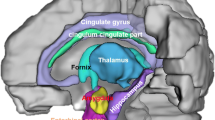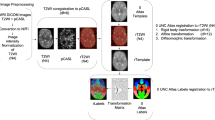Abstract
Early and accurate evaluation of the nature and extent of cerebral injury in the preterm infant brain is important for prognostication and decision making in the neonatal intensive care unit. The capability of magnetic resonance imaging (MRI) to define acute ischemic changes in white and gray matter in comparison to contemporaneous histopathology has not been adequately ascertained. The aim of this study is to assess whether postmortem MRI predicts the nature and extent of brain injury in a preterm fetal sheep model of cerebral hypoperfusion. MRI examinations were performed on fetal sheep brains (d99-100 gestation), perfusion fixed 72 hours after an ischemic insult (n = 7) with left-hemispheric placement of a microdialysis probe and compared with sham-occlusion (n = 3) and unoperated-control fetuses (n = 4). Cerebral ischemia was associated with MRI changes including global cerebral injury and diffuse white matter signal abnormality, which corresponded closely with histological damage. However, histological changes in deep structures, including the corona radiata, thalamus, and globus pallidus were not reliably detected on MRI. These findings confirm that in preterm fetal sheep, MRI can accurately assess cortical gray matter and subcortical and periventricular white matter abnormalities 3 days after hypoxic-ischemic injury but appears to have limited sensitivity to detect injury to deep structures.
Similar content being viewed by others
References
Marlow N., Wolke D., Bracewell MA, Samara M. Neurologic and developmental disability at six years of age after extremely preterm birth. N Engl J Med. 2005;352:9–19.
du Plessis AJ, Volpe JJ Perinatal brain injury in the preterm and term newborn. Curr Opin Neurol. 2002;15:151–157.
Salhab WA, Perlman JM Severe fetal acidemia and subsequent neonatal encephalopathy in the larger premature infant. Pediatr Neurol. 2005;32:25–29.
Barkovich AJ, Sargent SK Profound asphyxia in the premature infant: imaging findings. AJNR Am J Neuroradiol. 1995;16:1837–1846.
Barkovich AJ, Truwit CL Brain damage from perinatal asphyxia: correlation of MR findings with gestational age. AJNR Am J Neuroradiol. 1990;11:1087–1096.
Haynes RL, Folkerth RD, Keefe RJ, et al. Nitrosative and oxidative injury to premyelinating oligodendrocytes in periventricular leukomalacia. J Neuropathol Exp Neurol. 2003; 62:441–450.
Riddle A., Luo NL, Manese M., et al. Spatial heterogeneity in oligodendrocyte lineage maturation and not cerebral blood flow predicts fetal ovine periventricular white matter injury. J Neurosci. 2006;26:3045–3055.
Back SA, Han BH, Luo NL, et al. Selective vulnerability of late oligodendrocyte progenitors to hypoxia-ischemia. J Neurosci. 2002;22:455–463.
Back SA, Luo NL, Borenstein NS, Levine JM, Volpe JJ, Kinney HC Late oligodendrocyte progenitors coincide with the developmental window of vulnerability for human perinatal white matter injury. J Neurosci. 2001;21:1302–1312.
Rosenberg PA, Dai W., Gan XD, et al. Mature myelin basic protein-expressing oligodendrocytes are insensitive to kainate toxicity. J Neurosci Res. 2003;71:237–245.
Back SA, Luo NL, Mallinson RA, et al. Selective vulnerability of preterm white matter to oxidative damage defined by F2-isoprostanes. Ann Neurol. 2005;58:108–120.
Leijser LM, Klein RH, Veen S., Liauw L., Van Wezel-Meijler G. Hyperechogenicity of the thalamus and basal ganglia in very preterm infants: radiological findings and short-term neurological outcome. Neuropediatrics. 2004;35:283–289.
Paneth N., Rudelli R., Monte W., et al. White matter necrosis in very low birth weight infants: neuropathologic and ultrasonographic findings in infants surviving six days or longer. J Pediatr. 1990;116:975–984.
Gilles FH, Leviton A., Golden JA, Paneth N., Rudelli RD Groups of histopathologic abnormalities in brains of very low birth-weight infants. J Neuropathol Exp Neurol. 1998;57:1026–1034.
de Vries LS, Eken P., Groenendaal F., Rademaker KJ, Hoogervorst B., Bruinse HW Antenatal onset of haemorrhagic and/or ischaemic lesions in preterm infants: prevalence and associated obstetric variables. Arch Dis Child Fetal Neonatal Ed. 1998;78:F51–F56.
Bell JE, Becher JC, Wyatt B., Keeling JW, McIntosh N. Brain damage and axonal injury in a Scottish cohort of neonatal deaths. Brain. 2005;128:1070–1081.
Volpe JJ Encephalopathy of prematurity includes neuronal abnormalities. Pediatrics. 2005;116:221–225.
Yokochi K. Thalamic lesions revealed by MR associated with periventricular leukomalacia and clinical profiles of subjects. Acta Paediatr. 1997;86:493–496.
Argyropoulou MI, Xydis V., Drougia A., et al. MRI measurements of the pons and cerebellum in children born preterm: associations with the severity of periventricular leukomalacia and perinatal risk factors. Neuroradiology. 2003;45:730–734.
Lin Y., Okumura A., Hayakawa F., Kato K., Kuno T., Watanabe K. Quantitative evaluation of thalami and basal ganglia in infants with periventricular leukomalacia. Dev Med Child Neurol. 2001;43:481–485.
Inder TE, Warfield SK, Wang H., Huppi PS, Volpe JJ Abnormal cerebral structure is present at term in premature infants. Pediatrics. 2005;115:286–294.
Biagioni E., Mercuri E., Rutherford M., et al. Combined use of electroencephalogram and magnetic resonance imaging in full-term neonates with acute encephalopathy. Pediatrics. 2001;107:461–468.
Inder TE, Huppi PS, Warfield S., et al. Periventricular white matter injury in the premature infant is followed by reduced cerebral cortical gray matter volume at term. Ann Neurol. 1999;46:755–760.
Woodward LJ, Anderson PJ, Austin NC, Howard K., Inder TE. Neonatal MRI to predict neurodevelopmental outcomes in preterm infants. N Engl J Med. 2006;355:685–694.
Ajayi-Obe M., Saeed N., Cowan FM, Rutherford MA, Edwards AD Reduced development of cerebral cortex in extremely preterm infants. Lancet. 2000;356:1162–1163.
Panigrahy A., Barnes PD, Robertson RL, et al. Volumetric brain differences in children with periventricular T2-signal hyperintensities: a grouping by gestational age at birth. AJR Am J Roentgenol. 2001;177:695–702.
Felderhoff-Mueser U., Rutherford MA, Squier WV, et al. Relationship between MR imaging and histopathologic findings of the brain in extremely sick preterm infants. AJNR Am J Neuroradiol. 1999;20:1349–1357.
Fraser M., Bennet L., Gunning M., et al. Cortical electroencephalogram suppression is associated with post-ischemic cortical injury in 0.65 gestation fetal sheep. Dev Brain Res. 2005;154:45–55.
Barlow RM The foetal sheep: morphogenesis of the nervous system and histochemical aspects of myelination. J Comp Neurol. 1969;135:249–262.
McIntosh GH, Baghurst KI, Potter BJ, Hetzel BS Foetal brain development in the sheep. Neuropathol Appl Neurobiol. 1979; 5:103–114.
Schmued LC, Albertson C., Slikker W Jr. Fluoro-Jade: a novel fluorochrome for the sensitive and reliable histochemical localization of neuronal degeneration. Brain Res. 1997;751: 37–46.
Reddy K., Mallard C., Guan J., et al. Maturational change in the cortical response to hypoperfusion injury in the fetal sheep. Pediatr Res. 1998;43:674–682.
Mallard C., Welin AK, Peebles D., Hagberg H., Kjellmer I. White matter injury following systemic endotoxemia or asphyxia in the fetal sheep. Neurochem Res. 2003;28:215–223.
Welin AK, Sandberg M., Lindblom A., et al. White matter injury following prolonged free radical formation in the 0.65 gestation fetal sheep brain. Pediatr Res. 2005;58:100–105.
Dean JM, George SA, Wassink G., Gunn AJ, Bennet L. Suppression of post hypoxic-ischemic EEG transients with dizocilpine is associated with partial striatal protection in the preterm fetal sheep. Neuropharmacology. 2006;50:491–503.
George S., Scotter J., Dean JM, et al. Induced cerebral hypothermia reduces post-hypoxic loss of phenotypic striatal neurons in preterm fetal sheep. Exp Neurol. 2007;203:137–147.
George S., Gunn AJ, Westgate JA, Brabyn C., Guan J., Bennet L. Fetal heart rate variability and brainstem injury after asphyxia in preterm fetal sheep. Am J Physiol Regul Integr Comp Physiol. 2004;287:R925–R933.
Maalouf EF, Duggan PJ, Rutherford MA, et al. Magnetic resonance imaging of the brain in a cohort of extremely preterm infants. J Pediatr. 1999;135:351–357.
Counsell SJ, Kapellou O., Boardman JP, et al. Evidence for microstructural abnormalities in the white matter of preterm infants at term equivalent age demonstrated by diffusion tensor imaging. Early Hum Dev. 2004;77:118–119.
Dieni S., Inder T., Yoder B., et al. The pattern of cerebral injury in a primate model of preterm birth and neonatal intensive care. J Neuropathol Exp Neurol. 2004;63:1297–1309.
Cowan FM, de Vries LS. The internal capsule in neonatal imaging. Semin Fetal Neonatal Med. 2005;10:461–474.
Boardman JP, Counsell SJ, Rueckert D., et al. Abnormal deep grey matter development following preterm birth detected using deformation-based morphometry. Neuroimage. 2006;32:70–78.
Benveniste H., Blackband S. MR microscopy and high resolution small animal MRI: applications in neuroscience research. Prog Neurobiol. 2002;67:393–420.
Forbes KP, Pipe JG, Bird R. Neonatal hypoxic-ischemic encephalopathy: detection with diffusion-weighted MR imaging. AJNR Am J Neuroradiol. 2000;21:1490–1496.
Sie LT, van der Knapp MS, van Wezel-Meijler G., van AH, Lafeber HN, Valk J. Early MR features of hypoxic-ischemic brain injury in neonates with periventricular densities on sonograms. AJNR Am J Neuroradiol. 2000;21:852–861.
Miller SP, Cozzio CC, Goldstein RB, et al. Comparing the diagnosis of white matter injury in premature newborns with serial MR imaging and transfontanel ultrasonography findings. AJNR Am J Neuroradiol. 2003;24:1661–1669.
Cowan FM, Pennock JM, Hanrahan JD, Manji KP, Edwards AD Early detection of cerebral infarction and hypoxic ischemic encephalopathy in neonates using diffusion-weighted magnetic resonance imaging. Neuropediatrics. 1994;25:172–175.
Bozzao A., Di Paolo A, Mazzoleni C., et al. Diffusion-weighted MR imaging in the early diagnosis of periventricular leukomalacia. Eur Radiol. 2003;13:1571–1576.
Rutherford MA, Pennock JM, Counsell SJ, et al. Abnormal magnetic resonance signal in the internal capsule predicts poor neurodevelopmental outcome in infants with hypoxic-ischemic encephalopathy. Pediatrics. 1998;102:323–328.
Roelants-van Rijn AM, Groenendaal F., Beek FJ, Eken P., van Haastert IC, de Vries LS Parenchymal brain injury in the preterm infant: comparison of cranial ultrasound, MRI and neurodevelopmental outcome. Neuropediatrics. 2001;32:80–89.
Counsell SJ, Maalouf EF, Fletcher AM, et al. MR imaging assessment of myelination in the very preterm brain. AJNR Am J Neuroradiol. 2002;23:872–881.
Sie LT, van der Knaap MS, van Wezel-Meijler G., Valk J. MRI assessment of myelination of motor and sensory pathways in the brain of preterm and term-born infants. Neuropediatrics. 1997;28:97–105.
Norton WT Biochemistry of myelin. Adv Neurol. 1981;31: 93–121.
Author information
Authors and Affiliations
Corresponding author
Additional information
This work was supported in part by research grants from the Health Research Council of New Zealand, Lottery Health Grants Board of New Zealand, and Auckland Medical Research Foundation of New Zealand.
Rights and permissions
About this article
Cite this article
Fraser, M., Bennet, L., Helliwell, R. et al. Regional Specificity of Magnetic Resonance Imaging and Histopathology Following Cerebral Ischemia in Preterm Fetal Sheep. Reprod. Sci. 14, 182–191 (2007). https://doi.org/10.1177/1933719107299612
Published:
Issue Date:
DOI: https://doi.org/10.1177/1933719107299612




